Elution of Divalent Cations from Iron Ore Mining Waste in an Indirect Aqueous Mineral Carbonation for Carbon Capture and Storage
Abstract
1. Introduction
2. Materials and Methods
2.1. Raw Sample Preparation
2.2. Physicochemical and Mineralogical Analysis
2.3. Elution Experiment
2.3.1. Extracting Agent Concentration and Elution Time
2.3.2. Analytical and Post Elution Methods
2.4. CO2 Sequestration Potential
2.5. Post Elution CO2 Sequestration
3. Results and Discussion
3.1. Physicochemical and Mineralogical Properties
3.2. Elution of Fe, Mg and Ca
3.2.1. Oxalic Acid
3.2.2. Hydrochloric Acid
3.2.3. Formic Acid
3.2.4. Acetic Acid
3.3. pH Variation
3.4. Summary of Elution Results
3.5. Potential CO2 Sequestration
3.6. Experimental CO2 Sequestration
4. Conclusions
Supplementary Materials
Author Contributions
Funding
Institutional Review Board Statement
Informed Consent Statement
Data Availability Statement
Acknowledgments
Conflicts of Interest
References
- El-Assaly, A.; Ellis, R. Evaluation of recycling waste materials and by-products in highway construction. Int. J. Sustain. Dev. World Ecol. 2001, 8, 299–308. [Google Scholar] [CrossRef]
- Villa Gomez, D.; Sáez Salgado, E.; Mejías, O.; Pat-Espadas, A.M.; Pinedo Torres, L.A.; Jackson, L.; Parbhakar-Fox, A. Data Integration of Critical Elements from Mine Waste in Mexico, Chile and Australia. Minerals 2022, 12, 122. [Google Scholar] [CrossRef]
- Meseldzija, S.; Petrovic, J.; Onjia, A.; Volkov-Husovic, T.; Nesic, A.; Vukelic, N. Utilization of agro-industrial waste for removal of copper ions from aqueous solutions and mining-wastewater. J. Ind. Eng. Chem. 2019, 75, 246–252. [Google Scholar] [CrossRef]
- Azam, M.; Wabaidur, S.M.; Khan, M.R.; Al-Resayes, S.I.; Islam, M.S. Heavy metal ions removal from aqueous solutions by treated ajwa date pits: Kinetic, isotherm, and thermodynamic approach. Polymers 2022, 14, 914. [Google Scholar] [PubMed]
- Syed Hasan, S.N.M.; Mohd Kusin, F.; Nik Daud, N.N.; Saadon, M.A.; Mohamat-Yusuff, F.; Ash’aari, Z.H. Characterization of gold mining waste for carbon sequestration and utilization as supplementary cementitious material. Processes 2021, 9, 1384. [Google Scholar] [CrossRef]
- Alqadami, A.A.; Wabaidur, S.M.; Jeon, B.-H.; Khan, M.A. Co-hydrothermal valorization of food waste: Process optimization, characterization, and water decolorization application. Biomass Convers. Biorefin. 2023, 1–12. [Google Scholar] [CrossRef]
- Khan, M.A.; Wabaidur, S.M.; Siddiqui, M.R.; Alqadami, A.A.; Khan, A.H. Silico-manganese fumes waste encapsulated cryogenic alginate beads for aqueous environment de-colorization. J. Clean. Prod. 2020, 244, 118867. [Google Scholar]
- Ma, J.; Wang, P. Effects of rising atmospheric CO2 levels on physiological response of cyanobacteria and cyanobacterial bloom development: A review. Sci. Total Environ. 2021, 754, 141889. [Google Scholar] [CrossRef]
- Moser, S.C. Communicating climate change: History, challenges, process and future directions. Wiley Interdiscip. Rev. Clim. Chang. 2010, 1, 31–53. [Google Scholar] [CrossRef]
- Cebrucean, D.; Cebrucean, V.; Ionel, I. CO2 capture and storage from fossil fuel power plants. Energy Procedia 2014, 63, 18–26. [Google Scholar] [CrossRef]
- Lin, S.; Kiga, T.; Wang, Y.; Nakayama, K. Energy analysis of CaCO3 calcination with CO2 capture. Energy Procedia 2011, 4, 356–361. [Google Scholar]
- Markusson, N.; Kern, F.; Watson, J.; Arapostathis, S.; Chalmers, H.; Ghaleigh, N.; Heptonstall, P.; Pearson, P.; Rossati, D.; Russell, S. A socio-technical framework for assessing the viability of carbon capture and storage technology. Technol. Forecast. Soc. Chang. 2012, 79, 903–918. [Google Scholar] [CrossRef]
- Toroz, D.; Song, F.; Chass, G.A.; Di Tommaso, D. New insights into the role of solution additive anions in Mg2+ dehydration: Implications for mineral carbonation. CrystEngComm 2021, 23, 4896–4900. [Google Scholar] [CrossRef]
- Bobicki, E.R.; Liu, Q.; Xu, Z.; Zeng, H. Carbon capture and storage using alkaline industrial wastes. Prog. Energy Combust. Sci. 2012, 38, 302–320. [Google Scholar]
- Mouedhen, I.; Kemache, N.; Pasquier, L.-C.; Cecchi, E.; Blais, J.-F.; Mercier, G. Effect of pCO2 on direct flue gas mineral carbonation at pilot scale. J. Environ. Manag. 2017, 198, 1–8. [Google Scholar]
- Pasquier, L.-C.; Mercier, G.; Blais, J.-F.; Cecchi, E.; Kentish, S. Parameters optimization for direct flue gas CO2 capture and sequestration by aqueous mineral carbonation using activated serpentinite based mining residue. Appl. Geochem. 2014, 50, 66–73. [Google Scholar] [CrossRef]
- Arce, G.L.; Neto, T.G.; Ávila, I.; Luna, C.M.; dos Santos, J.C.; Carvalho, J.A., Jr. Influence of physicochemical properties of Brazilian serpentinites on the leaching process for indirect CO2 mineral carbonation. Hydrometallurgy 2017, 169, 142–151. [Google Scholar] [CrossRef]
- Dananjayan, R.R.T.; Kandasamy, P.; Andimuthu, R. Direct mineral carbonation of coal fly ash for CO2 sequestration. J. Clean. Prod. 2016, 112, 4173–4182. [Google Scholar]
- He, L.; Yu, D.; Lv, W.; Wu, J.; Xu, M. A novel method for CO2 sequestration via indirect carbonation of coal fly ash. Ind. Eng. Chem. Res. 2013, 52, 15138–15145. [Google Scholar] [CrossRef]
- Kim, M.-J.; Jung, S. Calcium elution from cement kiln dust using chelating agents, and CO2 storage and CaCO3 production through carbonation. Environ. Sci. Pollut. Res. 2020, 27, 20490–20499. [Google Scholar]
- Sanna, A.; Dri, M.; Hall, M.R.; Maroto-Valer, M. Waste materials for carbon capture and storage by mineralisation (CCSM)–A UK perspective. Appl. Energy. 2012, 99, 545–554. [Google Scholar] [CrossRef]
- Dri, M.; Sanna, A.; Maroto-Valer, M.M. Dissolution of steel slag and recycled concrete aggregate in ammonium bisulphate for CO2 mineral carbonation. Fuel Process. Technol. 2013, 113, 114–122. [Google Scholar] [CrossRef]
- Huntzinger, D.N.; Gierke, J.S.; Kawatra, S.K.; Eisele, T.C.; Sutter, L.L. Carbon dioxide sequestration in cement kiln dust through mineral carbonation. Environ. Sci. Technol. 2009, 43, 1986–1992. [Google Scholar] [CrossRef]
- Jo, H.; Park, S.-H.; Jang, Y.-N.; Chae, S.-C.; Lee, P.-K.; Jo, H.Y. Metal extraction and indirect mineral carbonation of waste cement material using ammonium salt solutions. Chem. Eng. J. 2014, 254, 313–323. [Google Scholar]
- Kusin, F.M.; Hasan, S.N.M.S.; Hassim, M.A.; Molahid, V.L.M. Mineral carbonation of sedimentary mine waste for carbon sequestration and potential reutilization as cementitious material. Environ. Sci. Pollut. Res. 2020, 27, 12767–12780. [Google Scholar] [CrossRef] [PubMed]
- Rahmani, O. CO2 sequestration by indirect mineral carbonation of industrial waste red gypsum. J. CO2 Util. 2018, 27, 374–380. [Google Scholar] [CrossRef]
- Pullin, H.; Bray, A.W.; Burke, I.T.; Muir, D.D.; Sapsford, D.J.; Mayes, W.M.; Renforth, P. Atmospheric carbon capture performance of legacy iron and steel waste. Environ. Sci. Technol. 2019, 53, 9502–9511. [Google Scholar] [CrossRef]
- Ramli, N.A.A.; Kusin, F.M.; Molahid, V.L.M. Influencing Factors of the Mineral Carbonation Process of Iron Ore Mining Waste in Sequestering Atmospheric Carbon Dioxide. Sustainability 2021, 13, 1866. [Google Scholar] [CrossRef]
- Meyer, N.; Vögeli, J.; Becker, M.; Broadhurst, J.; Reid, D.; Franzidis, J.-P. Mineral carbonation of PGM mine tailings for CO2 storage in South Africa: A case study. Miner. Eng. 2014, 59, 45–51. [Google Scholar] [CrossRef]
- Owais, M.; Järvinen, M.; Taskinen, P.; Said, A. Experimental study on the extraction of calcium, magnesium, vanadium and silicon from steelmaking slags for improved mineral carbonation of CO2. J. CO2 Util. 2019, 31, 1–7. [Google Scholar] [CrossRef]
- Vieira, K.R.; Arce, G.L.; Luna, C.M.; Facio, V.O.; Carvalho, J.A., Jr.; Neto, T.G.S.; Ávila, I. Understanding the acid dissolution of Serpentinites (Tailings and waste rock) for use in indirect mineral carbonation. S. Afr. J. Chem. Eng. 2022, 40, 154–164. [Google Scholar]
- Tong, Z.; Ma, G.; Zhou, D.; Yang, G.; Peng, C. The indirect mineral carbonation of electric arc furnace slag under microwave irradiation. Sci. Rep. 2019, 9, 7676. [Google Scholar] [CrossRef] [PubMed]
- Spínola, A.C.; Pinheiro, C.T.; Ferreira, A.G.; Gando-Ferreira, L.M. Mineral carbonation of a pulp and paper industry waste for CO2 sequestration. Process Saf. Environ. Prot. 2021, 148, 968–979. [Google Scholar] [CrossRef]
- Arce, G.L.; Neto, T.G.S.; Ávila, I.; Luna, C.M.; Carvalho, J.A., Jr. Leaching optimization of mining wastes with lizardite and brucite contents for use in indirect mineral carbonation through the pH swing method. J. Clean. Prod. 2017, 141, 1324–1336. [Google Scholar] [CrossRef]
- Galina, N.R.; Arce, G.L.; Maroto-Valer, M.; Ávila, I. Experimental Study on Mineral Dissolution and Carbonation Efficiency Applied to pH-Swing Mineral Carbonation for Improved CO2 Sequestration. Energies 2023, 16, 2449. [Google Scholar] [CrossRef]
- Teir, S.; Revitzer, H.; Eloneva, S.; Fogelholm, C.-J.; Zevenhoven, R. Dissolution of natural serpentinite in mineral and organic acids. Int. J. Miner. Process. 2007, 83, 36–46. [Google Scholar] [CrossRef]
- Razote, B.J.; Dela Cerna, K.M.; Patricio, M.J.; Eusebio, R.C.; Alorro, R.; Beltran, A.; Orbecido, A. Leaching characteristics of an iron-rich siltation pond waste and its viability in indirect carbon sequestration. Int. J. Min. Reclam. Environ. 2021, 35, 435–450. [Google Scholar] [CrossRef]
- Filippov, L.O.; Filippova, I.V.; Barres, O.; Lyubimova, T.P.; Fattalov, O.O. Intensification of the flotation separation of potash ore using ultrasound treatment. Miner. Eng. 2021, 171, 107092. [Google Scholar]
- Cengiz, S.; Karaca, A.C.; Çakır, İ.; Üner, H.B.; Sevindik, A. SEM–EDS analysis and discrimination of forensic soil. Forensic Sci. Int. 2004, 141, 33–37. [Google Scholar] [CrossRef]
- Kim, D.; Kim, M.-J. Calcium extraction from paper sludge ash using various solvents to store carbon dioxide. KSCE J. Civ. Eng. 2018, 22, 4799–4805. [Google Scholar]
- Reynes, J.F.; Mercier, G.; Blais, J.-F.; Pasquier, L.-C. Feasibility of a Mineral Carbonation Technique Using Iron-Silicate Mining Waste by Direct Flue Gas CO2 Capture and Cation Complexation Using 2,2′-Bipyridine. Minerals 2021, 11, 343. [Google Scholar]
- Kim, M.-J.; Kim, D. Maximization of CO2 storage for various solvent types in indirect carbonation using paper sludge ash. Environ. Sci. Pollut. Res. 2018, 25, 30101–30109. [Google Scholar]
- Sammes, P.G.; Yahioglu, G. 1,10-Phenanthroline: A versatile ligand. Chem. Soc. Rev. 1994, 23, 327–334. [Google Scholar] [CrossRef]
- Molahid, V.L.M.; Mohd Kusin, F.; Syed Hasan, S.N.M.; Ramli, N.A.A.; Abdullah, A.M. CO2 Sequestration through Mineral Carbonation: Effect of Different Parameters on Carbonation of Fe-Rich Mine Waste Materials. Processes 2022, 10, 432. [Google Scholar] [CrossRef]
- Mendoza, E.Y.M.; Santos, A.S.; López, E.V.; Drozd, V.; Durygin, A.; Chen, J.; Saxena, S.K. Iron oxides as efficient sorbents for CO2 capture. J. Mater. Res. Technol. 2019, 8, 2944–2956. [Google Scholar]
- Chou, C.-Y.; Loiland, J.A.; Lobo, R.F. Reverse water-gas shift iron catalyst derived from magnetite. Catalysts 2019, 9, 773. [Google Scholar] [CrossRef]
- Taxiarchou, M.; Panias, D.; Douni, I.; Paspaliaris, I.; Kontopoulos, A. Removal of iron from silica sand by leaching with oxalic acid. Hydrometallurgy 1997, 46, 215–227. [Google Scholar] [CrossRef]
- Lee, S.O.; Tran, T.; Park, Y.Y.; Kim, S.J.; Kim, M.J. Study on the kinetics of iron oxide leaching by oxalic acid. Int. J. Miner. Process. 2006, 80, 144–152. [Google Scholar] [CrossRef]
- Sun, Y.; Guan, F.; Yang, W.; Wang, F. Removal of chromium from a contaminated soil using oxalic acid, citric acid, and hydrochloric acid: Dynamics, mechanisms, and concomitant removal of non-targeted metals. Int. J. Environ. Res. Public Health 2019, 16, 2771. [Google Scholar] [CrossRef]
- Du, C.-M.; Yu, Y.-H.; Jiang, L.-D.; Yu, J.-K. Efficient extraction of phosphate from dephosphorization slag by hydrochloric acid leaching. J. Clean. Prod. 2022, 332, 130087. [Google Scholar]
- Matus, C.; Stopic, S.; Etzold, S.; Kremer, D.; Wotruba, H.; Dertmann, C.; Telle, R.; Friedrich, B.; Knops, P. Mechanism of nickel, magnesium, and iron recovery from olivine bearing ore during leaching with hydrochloric acid including a carbonation pre-treatment. Metals 2020, 10, 811. [Google Scholar] [CrossRef]
- Kim, M.-J.; Pak, S.Y.; Kim, D.; Jung, S. Optimum conditions for extracting Ca from CKD to store CO2 through indirect mineral carbonation. KSCE J. Civ. Eng. 2017, 21, 629–635. [Google Scholar]
- Cornell, R.M.; Schwertmann, U. The Iron Oxides: Structure, Properties, Reactions, Occurrences and Uses; John Wiley & Sons: Hoboken, NJ, USA, 2006. [Google Scholar]
- Pepper, R.A.; Couperthwaite, S.J.; Millar, G.J. Comprehensive examination of acid leaching behaviour of mineral phases from red mud: Recovery of Fe, Al, Ti, and Si. Miner. Eng. 2016, 99, 8–18. [Google Scholar] [CrossRef]
- Halli, P.; Hamuyuni, J.; Revitzer, H.; Lundström, M. Selection of leaching media for metal dissolution from electric arc furnace dust. J. Clean. Prod. 2017, 164, 265–276. [Google Scholar] [CrossRef]
- Ibiapina, V.F.; Florentino, U.d.S.; Afonso, J.C.; Gante, V.; Vianna, C.A.; Mantovano, J.L. Processing of spent Zinc-MnO2 dry cells in various acidic media. Quim. Nova 2018, 41, 176–183. [Google Scholar] [CrossRef]
- Gismonti, P.R.; Paulino, J.F.; Afonso, J. Recovery of metals from electroactive components of spent ni-mh batteries after leaching with formic acid. Detritus 2021, 14, 68. [Google Scholar]
- Jang, K.; Choi, W.Y.; Lee, D.; Park, J.; Yoo, Y. Purification of landfill gas by extracted calcium ions from municipal solid waste incineration fly ash. Sci. Total Environ. 2022, 807, 150729. [Google Scholar] [CrossRef] [PubMed]
- Bao, W.; Li, H.; Zhang, Y. Selective leaching of steelmaking slag for indirect CO2 mineral sequestration. Ind. Eng. Chem. Res. 2010, 49, 2055–2063. [Google Scholar] [CrossRef]
- Elomaa, H.; Seisko, S.; Lehtola, J.; Lundström, M. A study on selective leaching of heavy metals vs. iron from fly ash. J. Mater. Cycles Waste Manag. 2019, 21, 1004–1013. [Google Scholar] [CrossRef]
- Borra, C.R.; Pontikes, Y.; Binnemans, K.; Van Gerven, T. Leaching of rare earths from bauxite residue (red mud). Miner. Eng. 2015, 76, 20–27. [Google Scholar]
- Zhao, Q.; Li, J.; You, K.; Liu, C. Recovery of calcium and magnesium bearing phases from iron–and steelmaking slag for CO2 sequestration. Process Saf. Environ. Prot. 2020, 135, 81–90. [Google Scholar] [CrossRef]
- Chen, H.; Grassian, V.H. Iron dissolution of dust source materials during simulated acidic processing: The effect of sulfuric, acetic, and oxalic acids. Environ. Sci. Technol. 2013, 47, 10312–10321. [Google Scholar] [CrossRef] [PubMed]
- Pourbaix, M. Atlas of Electrochemical Equilibria in Aqueous Solutions; NACE: Bethlehem, PA, USA, 1966. [Google Scholar]
- Lee, S.O. Dissolution of Iron Oxides by Oxalic Acid; UNSW Sydney: Sydney, Australia, 2005. [Google Scholar]
- Lee, Y.H.; Eom, H.; Lee, S.M.; Kim, S.S. Effects of pH and metal composition on selective extraction of calcium from steel slag for Ca(OH)2 production. RSC Adv. 2021, 11, 8306–8313. [Google Scholar] [PubMed]
- Salmimies, R.; Mannila, M.; Kallas, J.; Häkkinen, A. Acidic dissolution of hematite: Kinetic and thermodynamic investigations with oxalic acid. Int. J. Miner. Process. 2012, 110, 121–125. [Google Scholar] [CrossRef]
- Basiri, N. A Curious Insight into Removal and Recovery of Ammonia from Struvite Thermal Decomposition Unit Outlet by Acidic Adsorption; University of British Columbia: Vancouver, BC, Canada, 2016. [Google Scholar]
- Abbaspour, A.; Mehrgardi, M.A.; Noori, A.; Kamyabi, M.A.; Khalafi-Nezhad, A.; Rad, M.N.S. Speciation of iron (II), iron (III) and full-range pH monitoring using paptode: A simple colorimetric method as an appropriate alternative for optodes. Sens. Actuators B Chem. 2006, 113, 857–865. [Google Scholar]
- Marczenko, Z.; Balcerzak, M. Separation, Preconcentration and Spectrophotometry in Inorganic Analysis; Elsevier: Amsterdam, The Netherlands, 2000. [Google Scholar]
- Yang, L.; Yao, G. A modified spectrophotometric method for the determination of ferrous ion during the Fenton process. Int. J. Environ. Anal. Chem. 2022, 102, 3194–3206. [Google Scholar] [CrossRef]
- Vydra, F.; Marková, V. Sorption of ferroin on silica and its analytical use. Talanta 1963, 10, 339–346. [Google Scholar]
- Shettima, A.U.; Hussin, M.W.; Ahmad, Y.; Mirza, J. Evaluation of iron ore tailings as replacement for fine aggregate in concrete. Constr. Build. Mater 2016, 120, 72–79. [Google Scholar] [CrossRef]
- Das, M.R.; Satapathy, S.; Pothal, L. A study on waste management in iron mining. Mater. Today Proc. 2023. [Google Scholar] [CrossRef]
- Vilela, A.P.; Eugênio, T.M.C.; de Oliveira, F.F.; Mendes, J.F.; Ribeiro, A.G.C.; Brandão, L.E.V.d.S.; Mendes, R.F. Technological properties of soil-cement bricks produced with iron ore mining waste. Constr. Build. Mater. 2020, 262, 120883. [Google Scholar] [CrossRef]
- Cao, L.; Zhou, J.; Zhou, T.; Dong, Z.; Tian, Z. Utilization of iron tailings as aggregates in paving asphalt mixture: A sustainable and eco-friendly solution for mining waste. J. Clean. Prod. 2022, 375, 134126. [Google Scholar] [CrossRef]

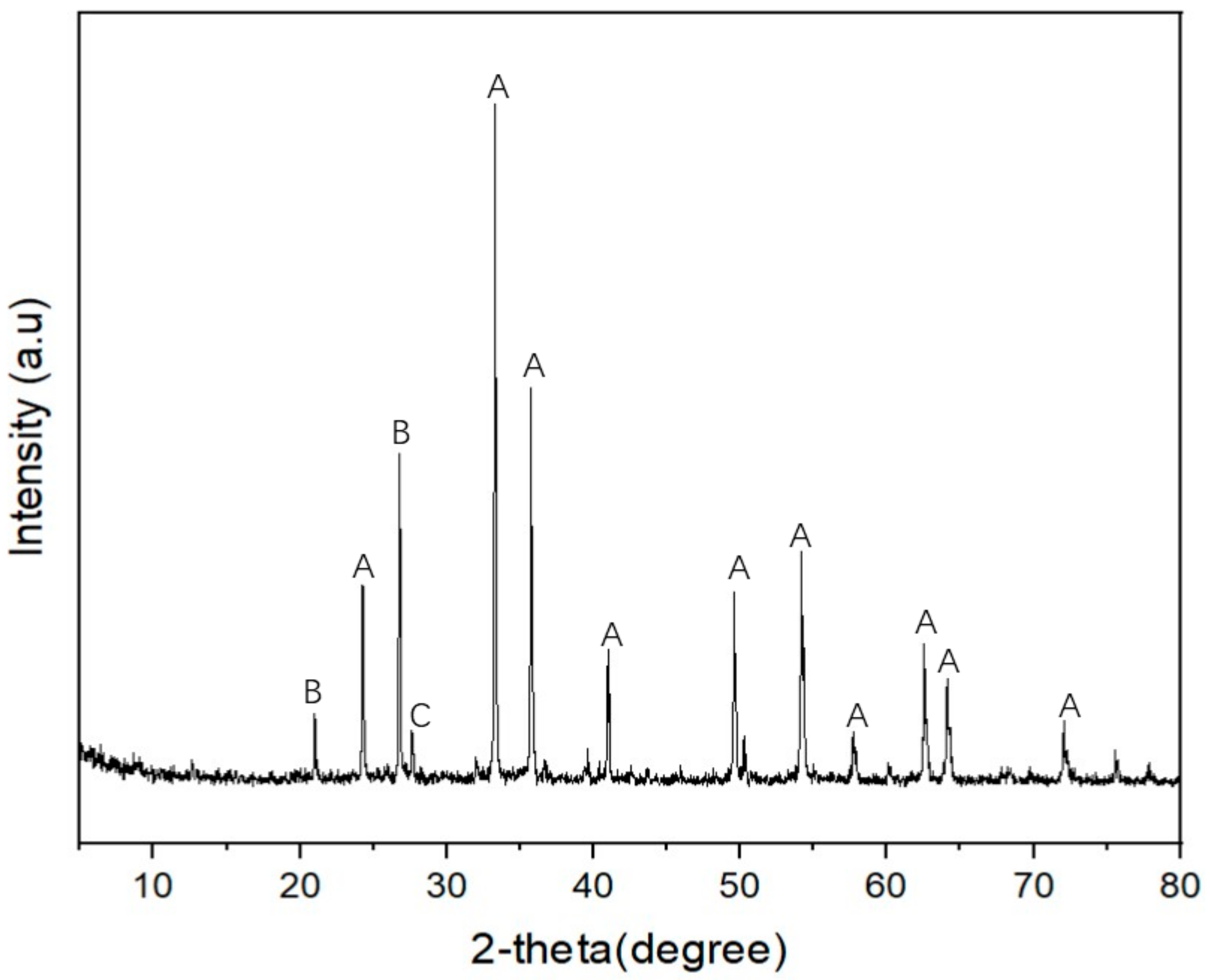
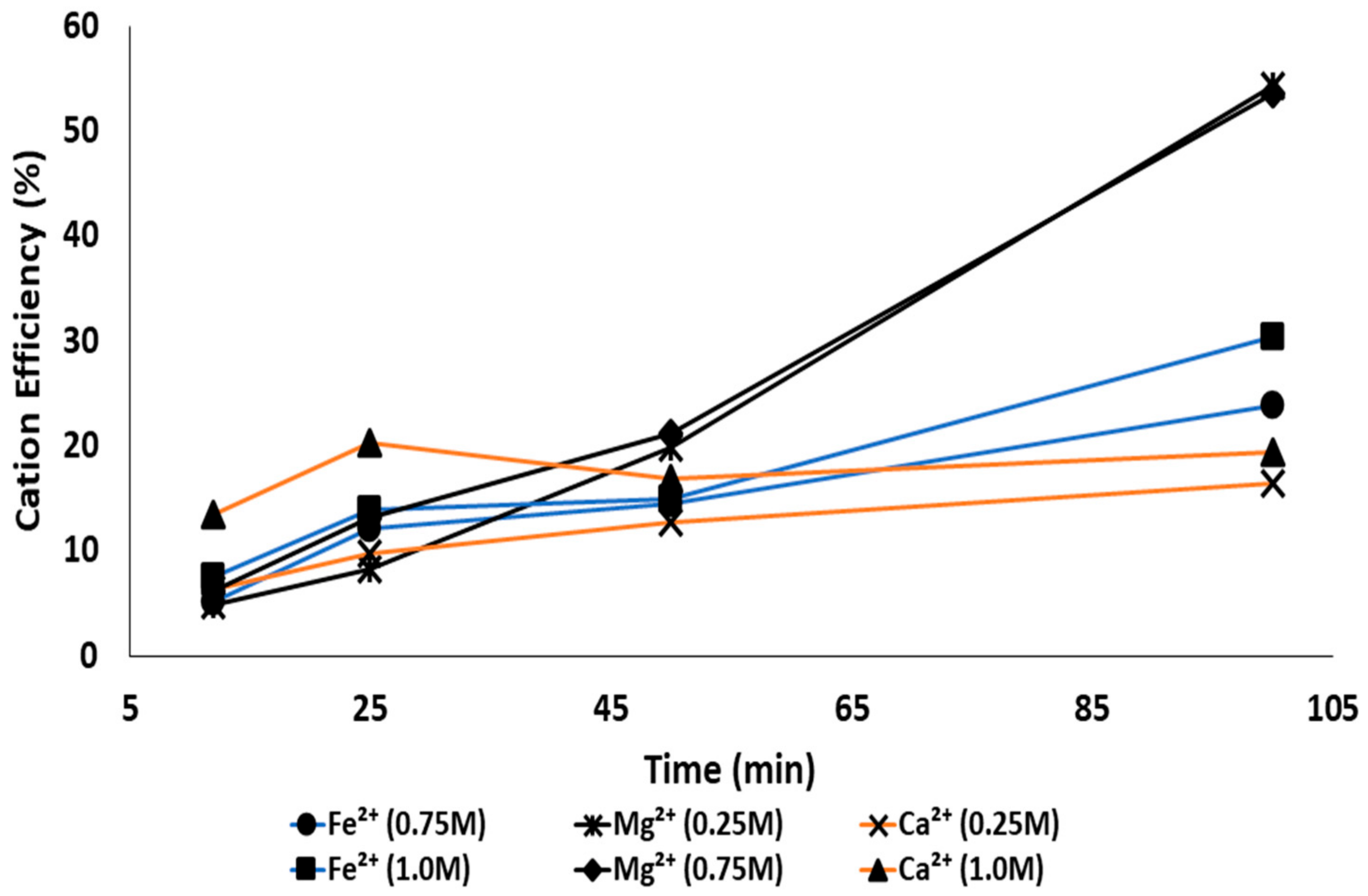
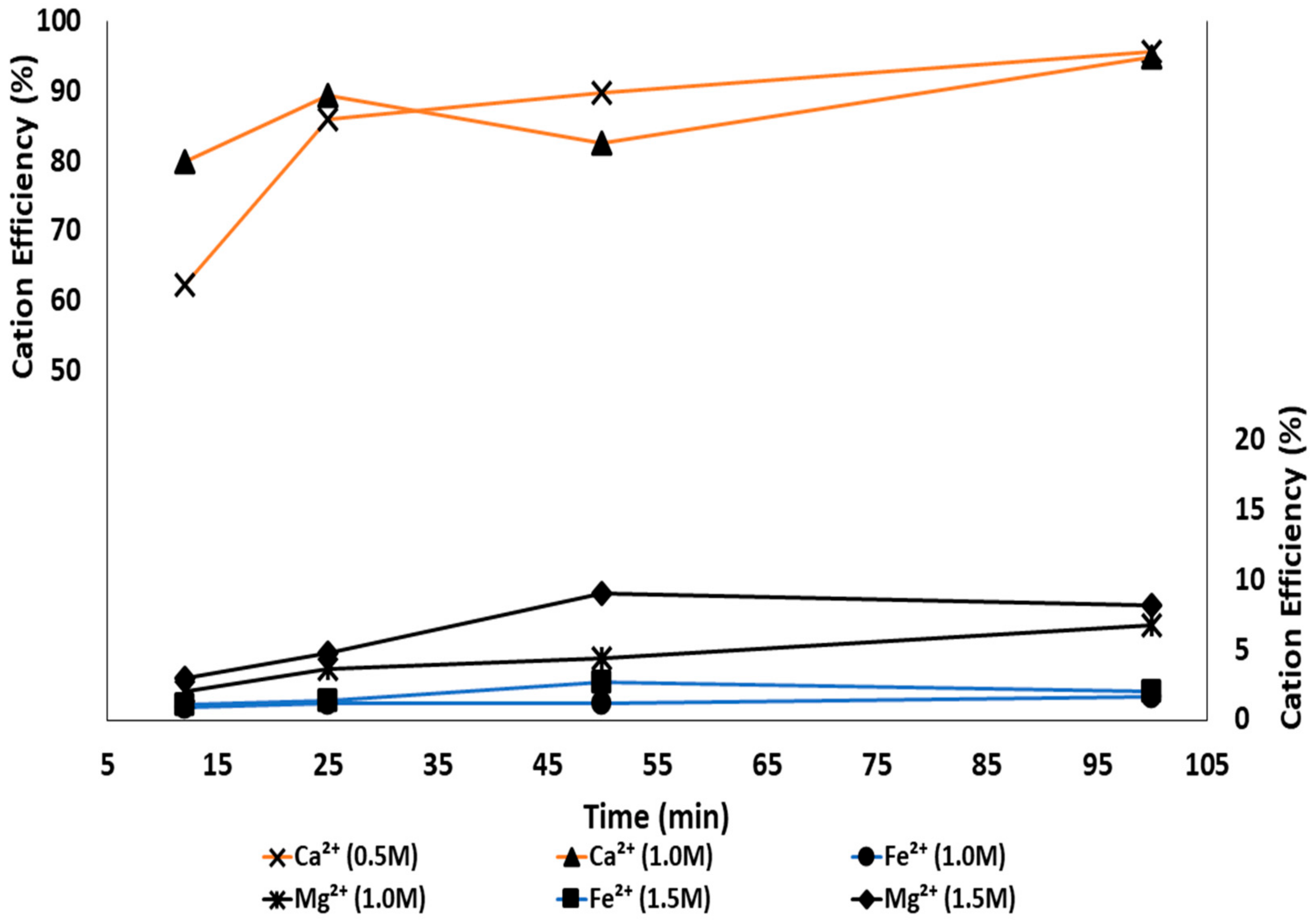
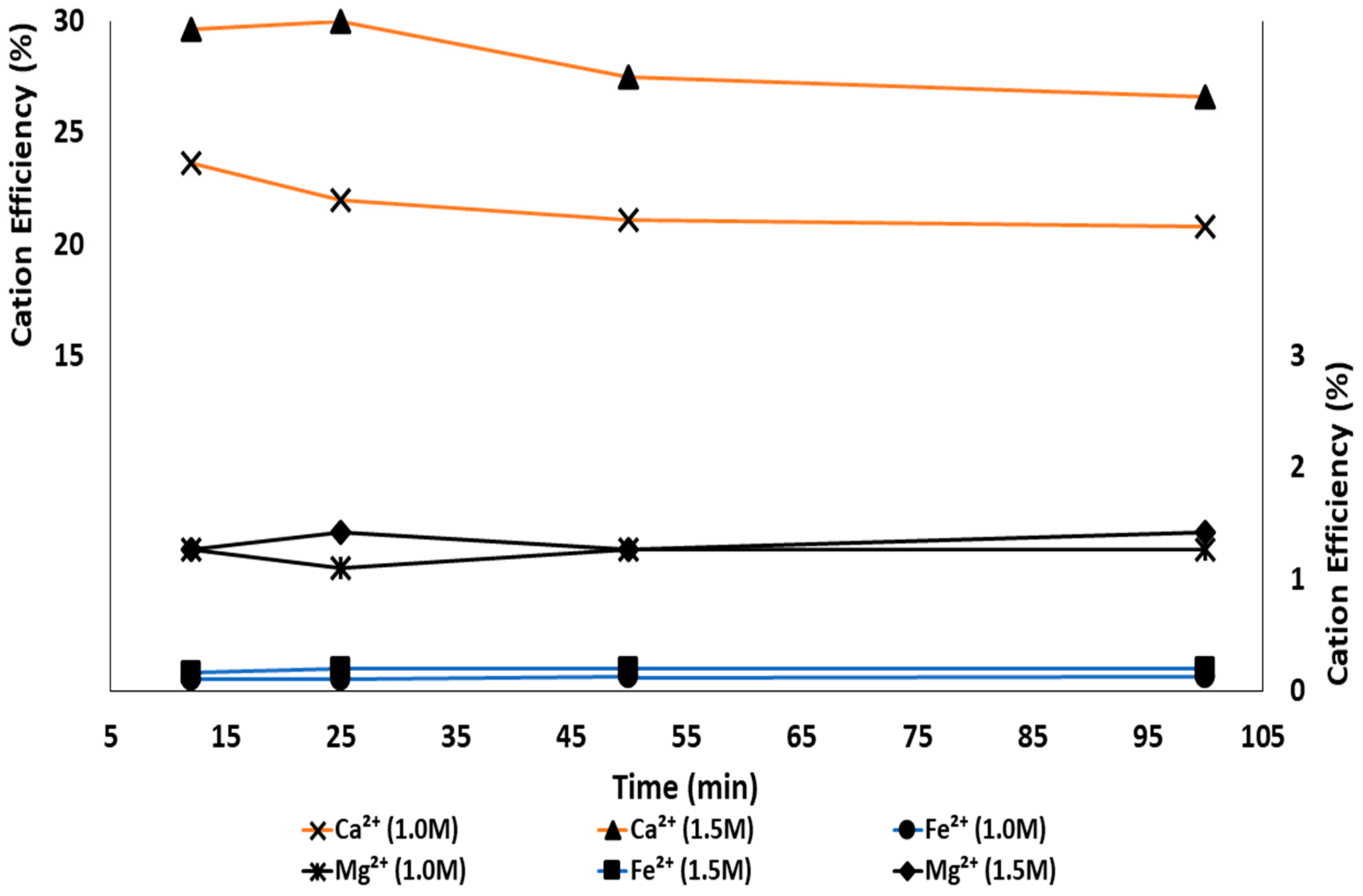
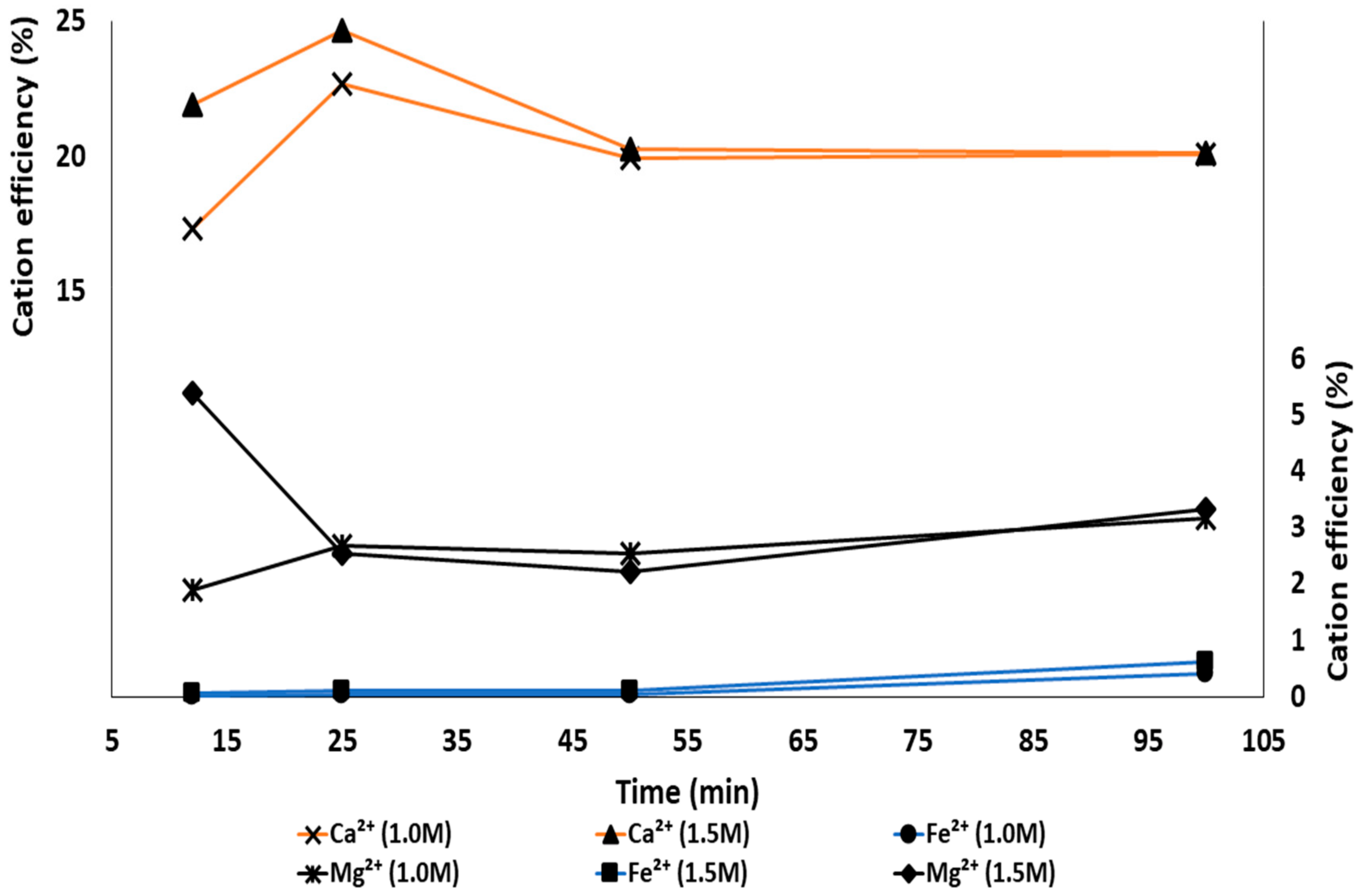
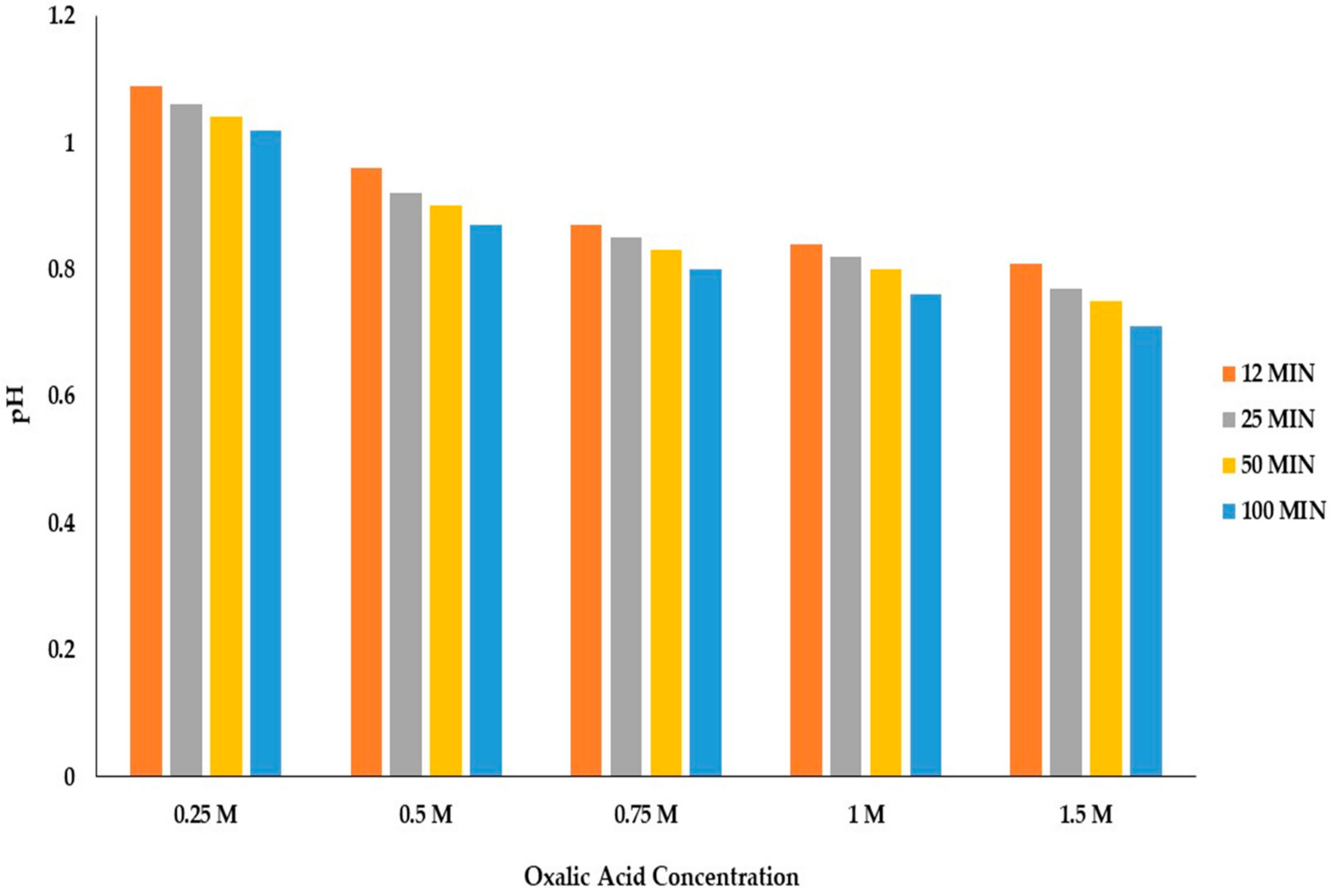
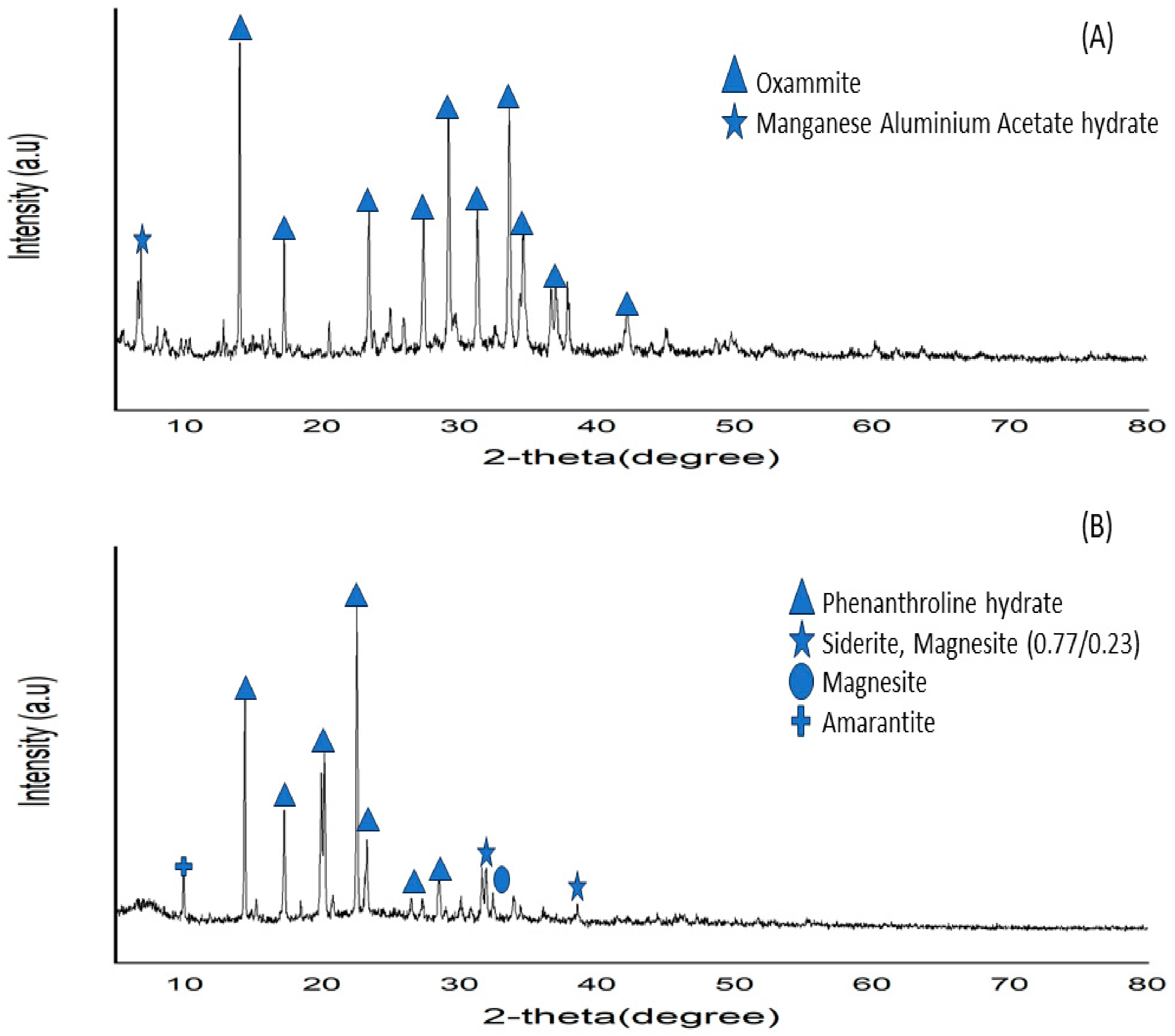
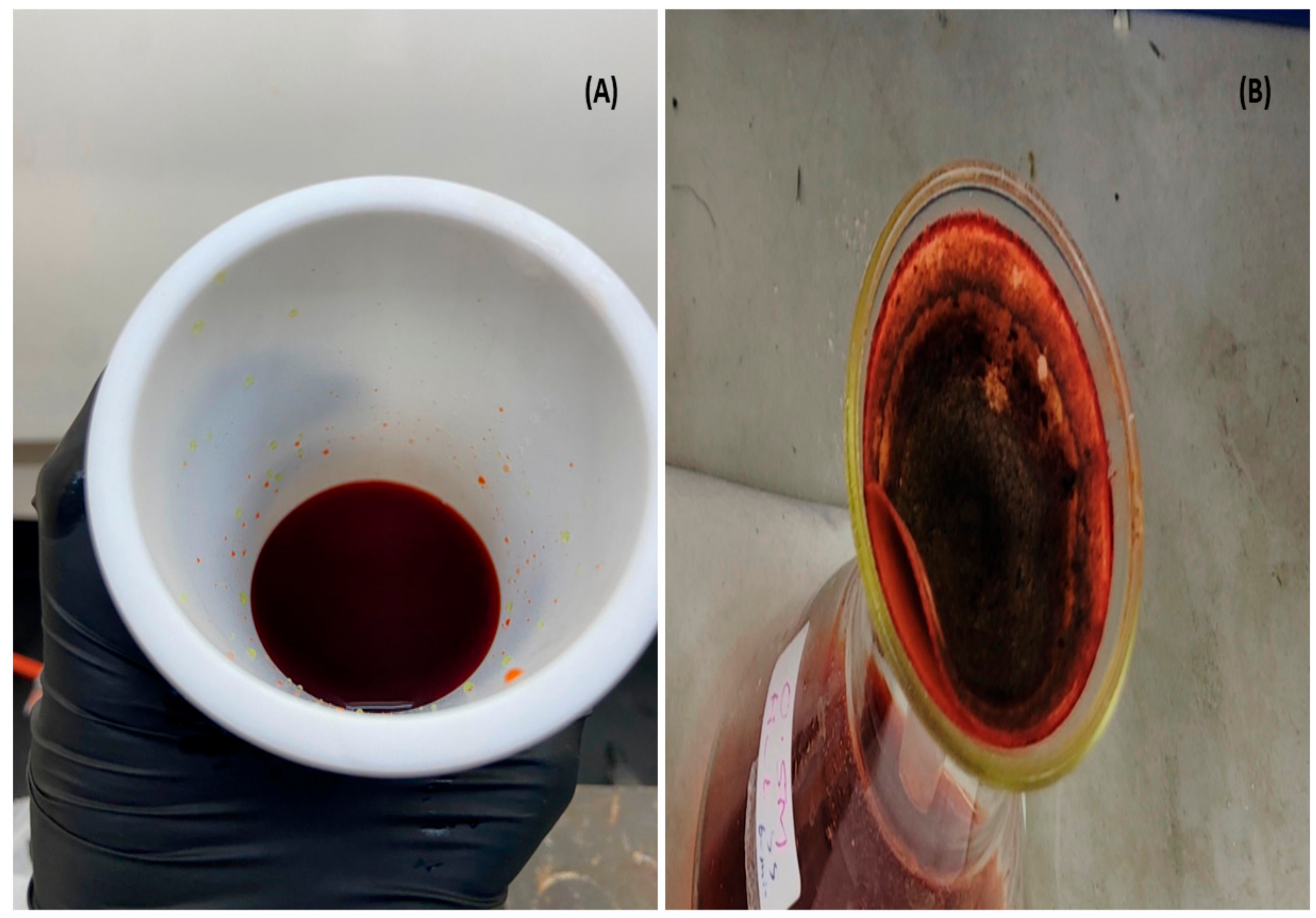
| Chemical Composition | Concentration (wt.%) |
|---|---|
| Fe | 45.95 |
| Si | 11.51 |
| Al | 3.69 |
| K | 1.47 |
| Ca | 1.45 |
| Mg | 0.63 |
| O | 34.56 |
| * Other trace metals (Ti, Ba, Mn, S, Cl, Cr, As) | 0.74 |
| Parameter/Acid | Oxalic | HCl | Formic | Acetic |
|---|---|---|---|---|
| Fe2+: | ||||
| Elution efficiency | 30.4% | 2.7% | 0.2% | 0.62% |
| Reaction time | 100 min | 50 min | 25 min | 100 min |
| Concentration | 1.0 M | 1.5 M | 1.5 M | 1.5 M |
| Mg2+: | ||||
| Elution efficiency | 54% | 9% | 1.4% | 5.3% |
| Reaction time | 100 min | 50 min | 25 min | 12 min |
| Concentration | 0.75 M | 1.5 M | 1.5 M | 1.5 M |
| Ca2+: | ||||
| Elution efficiency | 20% | 98% | 30% | 24.6% |
| Reaction time | 25 min | 50 min | 25 min | 25 min |
| Concentration | 1.0 M | 1.5 M | 1.5 M | 1.5 M |
| Oxalic Acid | p-Value | Status |
|---|---|---|
| Fe leaching of all solution concentrations | 0.51 | Non-Significant |
| Fe leaching of all reaction time | 0.002 | Significant |
| Mg leaching of all solution concentrations | 0.85 | Non-Significant |
| Mg leaching of all reaction time | 0.001 | Significant |
| HCl | p-Value | Status |
| Ca leaching of all solution concentrations | 0.64 | Non-Significant |
| Ca leaching of all reaction time | 0.001 | Significant |
| Fe * | Mg * | Ca * | ||||
|---|---|---|---|---|---|---|
| Theoretical | Experimental | Theoretical | Experimental | Theoretical | Experimental | |
| CO2 sequestration | 110 mg CO2/g | 44.1 mg CO2/g | 6.12 mg CO2/g | 1.05 mg CO2/g | 15.46 mg CO2/g | 8.73 mg CO2/g |
Disclaimer/Publisher’s Note: The statements, opinions and data contained in all publications are solely those of the individual author(s) and contributor(s) and not of MDPI and/or the editor(s). MDPI and/or the editor(s) disclaim responsibility for any injury to people or property resulting from any ideas, methods, instructions or products referred to in the content. |
© 2024 by the authors. Licensee MDPI, Basel, Switzerland. This article is an open access article distributed under the terms and conditions of the Creative Commons Attribution (CC BY) license (https://creativecommons.org/licenses/by/4.0/).
Share and Cite
Soomro, M.H.; Mohd Kusin, F.; Mohamat-Yusuff, F.; Nik Daud, N.N. Elution of Divalent Cations from Iron Ore Mining Waste in an Indirect Aqueous Mineral Carbonation for Carbon Capture and Storage. Sustainability 2024, 16, 836. https://doi.org/10.3390/su16020836
Soomro MH, Mohd Kusin F, Mohamat-Yusuff F, Nik Daud NN. Elution of Divalent Cations from Iron Ore Mining Waste in an Indirect Aqueous Mineral Carbonation for Carbon Capture and Storage. Sustainability. 2024; 16(2):836. https://doi.org/10.3390/su16020836
Chicago/Turabian StyleSoomro, Muhammad Hameer, Faradiella Mohd Kusin, Ferdaus Mohamat-Yusuff, and Nik Norsyahariati Nik Daud. 2024. "Elution of Divalent Cations from Iron Ore Mining Waste in an Indirect Aqueous Mineral Carbonation for Carbon Capture and Storage" Sustainability 16, no. 2: 836. https://doi.org/10.3390/su16020836
APA StyleSoomro, M. H., Mohd Kusin, F., Mohamat-Yusuff, F., & Nik Daud, N. N. (2024). Elution of Divalent Cations from Iron Ore Mining Waste in an Indirect Aqueous Mineral Carbonation for Carbon Capture and Storage. Sustainability, 16(2), 836. https://doi.org/10.3390/su16020836







